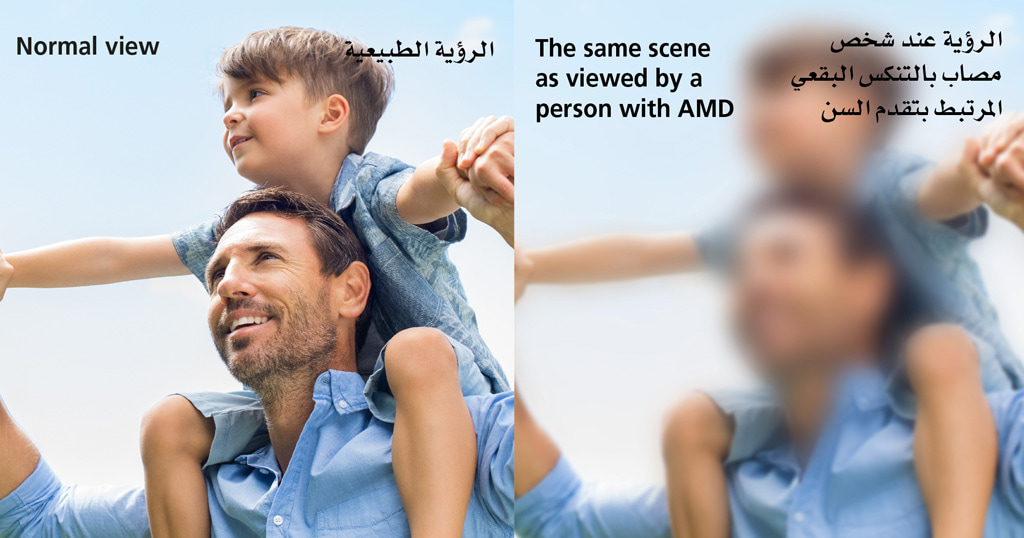
Age-Related Macular Degeneration
Age-Related Macular Degeneration
Age-Related Macular Degeneration (AMD) is one of the most common causes of the loss of vision in people aged 50 and older. Worldwide, the number of people with age-related macular degeneration is projected to reach 196 million by 2020, increasing to 288 million by 2040. (1)
The vision loss occurs due to damage to the central part of the retina, or macula, which is the most sensitive part of the retina and enables us to have sharp and detailed vision when we look straight ahead. When the macula is damaged, the centre of our field of vision may appear blurred, distorted, or dark. This loss of central vision, even without leading to complete blindness, can still however interfere with everyday tasks such as reading, writing, driving or recognising faces.
The progression rate of the disease varies and when it is in the initial stages, any vision-related symptoms may develop slowly. However, there are cases in which the progression of the disease is rapid and loss of vision may be sudden.
The most significant risk factor for AMD is age but research has shown that smoking doubles the risk of AMD. Furthermore, AMD is more common among certain groups within the community and genetics are relevant because people with a family history of AMD are at higher risk, and more than 20 genes have now been identified as affecting the risk of developing AMD (source nei.nih.gov).
In the early and intermediate stages, AMD can typically be detected only with a comprehensive examination of the retina, often using dilating drops to provide a better view of the back of the eye. The examination normally includes the measurement of visual acuity, visualisation of the retina with a slit lamp and ancillary tests such as OCT and Fluorescein & Indocyanine Green Angiography (FFA & ICGA).
Early AMD;
the disease is characterised by the presence of medium-sized drusen (yellow deposits beneath the retina). People with early AMD typically do not have vision loss.
Initially there may be no symptoms but over time the quality of the vision deteriorates. The sharpness of vision may be lost and colours may appear washed out and lack definition. Glare is another symptom that may be experienced.
Intermediate AMD;
in these cases, drusen are larger and often joined together and may be associated with pigment changes in the retina. At this stage there may be some vision loss, but most people will not experience any symptoms.
Late AMD;
in addition to drusen, people with late AMD have vision loss caused by damage to the macula. There are two types of late AMD:
1: Geographic Atrophy (also called dry AMD) in which the progressive damage from drusen ultimately leads to cell death and loss of vision
2: Neovascular AMD (also called wet AMD) in which abnormal blood vessels grow underneath or through the retina. These vessels can leak fluid and blood, which accumulates in the retina leading to swelling and damage of the macula. The damage may be very quick and severe.
It is possible to have both geographic atrophy and neovascular AMD in the same eye, and either type can appear first.
Whilst there is no specific treatment for early AMD, research has found that daily intake of certain high-dose vitamins and minerals can slow progression of the disease in people who have intermediate AMD, and in those who have late AMD in one eye only. The first AREDS trial showed that a combination of vitamin C, vitamin E, beta-carotene, zinc, and copper can reduce the risk of late AMD by 25 percent.
With neovascular AMD, abnormally high levels of vascular endothelial growth factor (VEGF) are secreted in the eyes – VEGF is a protein that promotes the growth of new abnormal blood vessels. Anti-VEGF injection therapy blocks this growth and therefore slows the progression of the disease.
Today, most neovascular AMD is treated with intravitreal injections, with laser being reserved for a selected minority of cases. Typically, multiple monthly injections are required and the earlier treatment starts, the higher the chances of better vision results.
AMD has few symptoms in the early stages, so it is important to have your eyes examined regularly. If you are at risk of AMD because of age, family history, lifestyle, or some combination of these factors, you should not wait for changes in your vision before being checked for AMD.
If you have late AMD in one eye only, you may not notice any changes in your overall vision. With the other eye seeing clearly, you may still be able to drive, read, and see fine details. However, having late AMD in one eye means you are at increased risk of late AMD in your other eye.
1 Wong, WL Lancet Glob Health. 2014 Feb;2(2):e106-16
2 nei.nih.gov